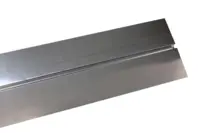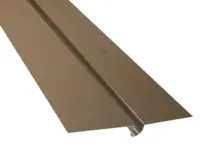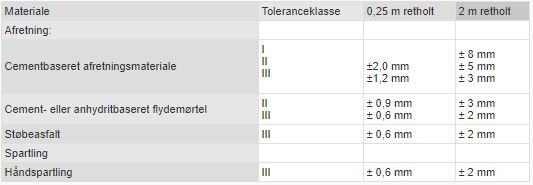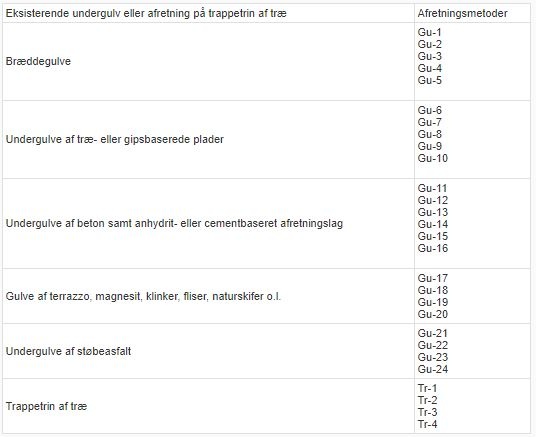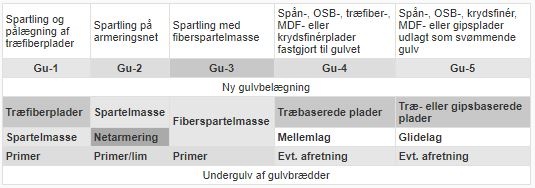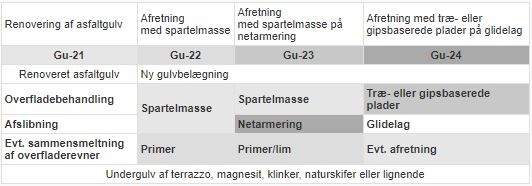- Forside
- Gode råd om gulv
- Vedligeholdelse
- Renovering
- Akustikpaneler
- Afpassede tæpper
- Bambusgulve
- Bordplader & bordben
- Designgulve
- Fliser og klinker
- BeefEater gasgrill
- Gode råd om gulv
- Gulvtæpper
- Gulvvarme
- Græstæpper
- Korkgulve
- Køkken, bad & garderobe
- Laminatgulve
- Linoleumsgulve
- Maling, Væv & Spartel
- Måtter
- Møbler & Boliginteriør
- Nålefilt og messetæpper
- Plejeprodukter
- Restpartier & gode tilbud
- Sildebensparket & Stavparket
- Tæppefliser
- Terrassebrædder
- Tilbehør
- Trægulve
- Vareprøver
- Vinylgulv
- Værktøj
- Øvrige produkter
- Loft- og vægpaneler
- Flotte gulve
- Fyrretræsgulv
- Klikgulve
- Bestilte varer
-
-26%
-
Populær29,00 DKK
-
29,00 DKK pr m2
-
Populær21,00 DKK
-
29,00 DKK pr m2
Renovering
Alle informationer på denne side er kopieret materiale fra Gulvfakta som er et fagteknisk opslagsmateriale, Kilde: Gulvfakta
Ved renovering af gulve og trapper forstås (normalt), at den eksisterende gulvbelægning eller den eksisterende overfladebehandling udskiftes. I forbindelse hermed kan der også være behov for opretning af eksisterende underlag.
5.1.0.1 Introduktion og afgrænsning
5.1.0.2 Krav til underlag ved gulv og trapperenovering
5.1.0.3 Stabile underlag
5.1.0.4 Tørre underlag
5.1.0.5 Plane underlag
5.1.0.6 Anvendelighed til vandbaserede produkter
5.1.0.7 Aftalegrundlag
5.1.0.8 Tilstandsvurdering
5.1.0.9 Gulv og trapperenovering
Alle informationer på denne side er kopieret materiale fra Gulvfakta som er et fagteknisk opslagsmateriale, Kilde: Gulvfakta
5.1.0.1 Introduktion og afgrænsning
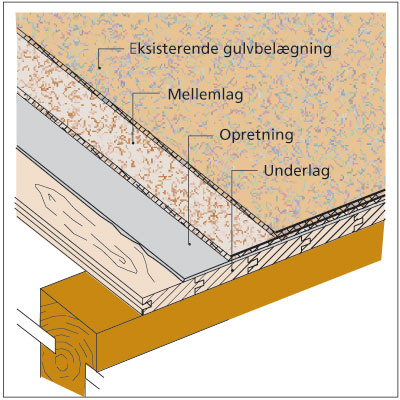
Figur 1. Eksempel på gulvopbygning.
Renovering af trægulve ved afslibning eller afhøvling, hvor den gamle overfladebehandling (slidflade) fjernes og erstattes med en ny, er beskrevet i i afsnittet Overfladebehandling og indgår derfor ikke i dette afsnit. Dette afsnit gennemgår de krav, der stilles til gulv- og trappeunderlag i forbindelse med renovering, peger på risikomomenter, der skal tages hensyn til, og giver vejledning til hjælp ved planlægning, projektering og udførelse af renovering af trapper og gulv. Endvidere gives eksempler på afretningsmetoder og beskrivelsespositioner, som kan medvirke til at gøre udbudsog aftalegrundlag i renoveringssager ensartede. Afsnittet omhandler ikke selve gulvbelægningen, materialerne eller arbejdets udførelse. Gulvbelægninger, gulvunderlag, hjælpematerialer mv. er udførligt beskrevet andre steder i Gulvbranchens Gulvfakta.
5.1.0.2 Krav til underlag ved gulv og renovering af trapper
En forudsætning for at opnå gode og velfungerende belægninger på gulve og trapper er et godt underlag. For at den samlede gulvkonstruktion skal fungere som ønsket, skal der være en samvirke mellem gulvbelægningen og dens underlag/undergulv og desuden med omgivelserne, fx den bærende konstruktion, underliggende terræn eller omgivende vægge. Det er derfor nødvendigt, at underlaget har en række egenskaber, som dels afhænger af den aktuelle gulvbelægning, dels af bygningsfysiske krav til hele gulvkonstruktionen.
Underlag for gulv- og trappebelægninger skal være:
• Stabile
• Tørre
• Plane
• Klæbbare
• Anvendelige til vandbaserede produkter
5.1.0.3 Stabile underlag
Betongulve
Gamle undergulve af beton o.l. skal være intakte, og overfladen skal være uden større revner. Hvis betongulvet er afrettet med betonslidlag, flydemørtel eller spartelmasse, må der ikke forekomme vedhæftningsbrud mellem afretningslaget og betongulvet.
Trapper af beton
Trapper af beton udgør som regel et stabilt underlag for nye belægninger. Kanter på trin og reposer skal være rette og uden skår. Eventuelle afretningslag på trin og reposer skal ligge fast til underlaget.
Gulve af brædder eller plader
Gulve af gulvbrædder eller træbaserede plader på bjælkelag eller strøkonstruktioner skal være udført med samlinger med fer og not eller evt. løse sløjfer. Materialetykkelsen skal være afstemt til gulvets understøtningsafstand, dvs. afstanden mellem bjælker eller strøer. Gulvbrædder eller gulvplader skal være fastgjort forsvarligt til understøtningerne med søm eller skruer. Stødsamlinger i bræddegulve og tværsamlinger i pladegulve skal være understøttet af bjælker eller strøer.
For pladegulve skal pladekanter langs vægge o.l. være understøttet. I ældre etageejendomme er eksisterende bræddegulve i køkkener og entreer ofte slidt ned, og de kan derfor ikke umiddelbart anvendes som undergulve for nye gulvbelægninger. Flytning af skillevægge, omlægning af el og vand betyder desuden, at der ofte er mange opskæringer i disse gulve. De kan derfor med fordel fjernes helt og erstattes af nye undergulve af fx spån- eller krydsfinérplader, som lægges på et nyt, oprettet underlag.
Trapper af træ
Trin og stødtrin i trapper af træ skal sidde fast og være uden knirkelyde, når trappen benyttes. Trappens forvange skal være i fast forbindelse med hovedstykket, og bagvangen skal være fastholdt forsvarligt til væggen. Gulve på reposer skal være stabile. Gulvbrædder på trappereposer kan være slidt i et omfang, der nødvendiggør en udskiftning af hele gulvet.
5.1.0.4 Tørre underlag
Før der lægges gulv, skal underlaget være så tørt, at den ønskede gulvbelægning kan pålægges uden problemer. Fugt og gulve er nærmere beskrevet i afsnittet Valg af gulv, Byggetekniske forudsætninger.
Byggefugt
For at begrænse opfugtning af gulvkonstruktionerne er det vigtigt fra begyndelsen af renoveringsarbejdet at holde kældre, trappeopgange og lign. lukkede og tørre. Andre arbejder, som kan tilføre rummet fugt i større omfang, fx murerarbejde og grundlæggende malerarbejde, skal udføres så tidligt i renoveringsforløbet, at fugtafgivelsen ikke sinker gulvarbejdet. Forhold i forbindelse med byggefugt ved renovering følger i øvrigt de samme retningslinier, som gælder ved nybyggeri.
Indtrængende fugt
For at undgå problemer med indtrængende grundfugt bør fugtkilderne identificeres og elimineres, fx ved udførelse af en effektiv fugtspærre. Kældergulve og terrrændæk af beton kan normalt anvendes til belægning med diffusionsåbne materialer, fx klinker eller textile belægninger uden gummibagside. Skal der lægges trægulve eller diffusionstætte belægninger, fx vinyl eller linoleum, skal det sikres, at der ikke er opstigende grundfugt. Selv hvis det er oplyst, at der er udført fugtspærre, bør der altid udføres fugtmålinger inden gulvlægning for at sikre, at fugtspærren også fungerer.
Hvis ligevægtsfugtindholdet i gamle betongulve er over ca. 65 % RF, bør der altid etableres en effektiv fugtspærre af fx støbeasfalt, epoxy eller lignende inden gulvlægningen.
Etageadskillelser over kældre kan være belastet af fugt, som trænger ind fra fugtige kælderydervægge eller skyldes permanent høj luftfugtighed i kælderetagen. Hvis luftfugtigheden ikke bringes ned ved opvarmning og udluftning, kan træbjælkelag risikere fugtindhold på over 20%. Udover fare for svampeangreb, kan det høje fugtindhold medføre, at gulvbrædderne vil få tværkrumninger og derved give gulvet "vaskebræteffekt". Fugtskadede bræddegulve, der afrettes ved afslibning eller spartling, kan inden for kort tid atter få skader, fx vaskebræteffekt, hvis ikke fugtkilderne fjernes, før gulvarbejdet udføres.
Fugtproblemer i trægulve på strøer på terrændæk viser sig ofte ved, at gulvet har vaskebræteffekt. Grunden er især manglende fugtspærre eller fejlagtig placering af al isoleringen over fugtspærren, som er udlagt på oversiden af betonpladen. Utætte rørinstallationer under trægulvet vil give tilsvarende problemer. I huse og mindre byejendomme, der er opført i første halvdel af dette århundrede, kan der i stueetagen være anvendt en uisoleret bjælkelagskonstruktion over jordgulv. Ofte er der ingen adgang til hulrummet mellem bjælkelag og jord, og konstruktionen kan derfor kun undersøges ved at fjerne en del af gulvet. Trapper og reposer af træ kan være helt eller delvis nedbrudt af fugt.
5.1.0.5 Plane underlag
Et gulvs planhed og vandrethed bedømmes normalt visuelt. Planheden kan imidlertid være afgørende for gulvets eller trappens rette funktion, og bedømmelsen bør derfor foretages på baggrund af måling af planheden.
Planhed er nærmere beskrevet i afsnittet Planhed og gulve.
Krav
Planhedskrav bør fastlægges ud fra en vurdering, som bygger på gulvets fremtidige funktion og de aktuelle forhold. Kravene bør ikke være strengere end højst nødvendigt, da krav om små tolerancer på planhed og vandrethed kan være meget kostbare at opnå i praksis.
Gamle bræddegulve
Gamle bræddegulve ligger ofte på træbjælkelag med slappe/hængende bjælker, og bjælkelaget kan tillige være blevet vindskævt som følge af sætninger i bygningens bærende konstruktioner. I sådanne tilfælde vil det normalt ikke være muligt at opnå en planhedstolerance mindre end ± 4 mm på 2 m. Krav bør stilles på baggrund af en måling og registrering af den eksisterende overflade og gulvets fremtidige anvendelse. Endvidere kan krav til koter ved tilslutning til elevatorer og trapper samt brand- og lyddøre blive afgørende for hvilken planhed og vandrethed, der kan opnås på et oprettet gulv.
Trapper af træ
Sætninger i hovedskillevægge og trappevægge kan have gjort reposerne så skæve, at der er grænser for, hvor vandrette og plane de kan blive efter opretning. Problemet ses især ved hovedreposer, hvor muligheden for opretning er begrænset som følge af gulvets tilslutning til trappeløb og entrédøre.
Afretning/spartling
Afretning af et ujævnt undergulv kan normalt ikke foretages alene ved spartling. Spartling må kun betragtes som en klæbebund for gulvbelægninger, der limes til underlaget. Hvis der ikke stilles specifikke krav til planhed af det færdige gulv, og der ikke er givet oplysninger om det eksisterende undergulvs planhed, vil tilbudsudregning være baseret på én gang spartling. Den bærende konstruktion leveres imidlertid ofte med forholdsvis store ujævnheder, fx leveres støbte gulve ofte med en tolerance på ± 8 mm på et 2 meter retholt (klasse A i CtO´s publikation, Gulvkonstruktioner af beton). På dette underlag skal gulventreprenøren i de fleste tilfælde aflevere et færdigt gulv med en tolerance på ± 2 mm på et 2 meter retholt. Der må derfor foretages en udligning mellem de to tolerancer ved afretning af dækket, før lægning af gulv er mulig. Afretning kan fx ske med flydemørtel, puds, sand eller granulerede materialer.
Forbruget af afretningsmateriale kan bestemmes ud fra:
• Den forventede tolerance for planheden af den dækkonstruktion, som gulvet skal lægges på, fx ± 8 mm
• Den ønskede tolerance for planheden af færdig gulvoverflade, fx ± 2 mm
• Behovet for udligning af koteforskelle, fx ved elevatorer, trappereposer, døre og lign.
• Ønske om vandrethed/acceptabel pilhøjde (må færdigt gulv følge dækelementets overside helt eller delvis, eller skal der afrettes til vandret overflade).
Tabel 1. Opnåelige tolerancer ved forskellige former for afretning/spartling.
Ved håndspartling over større arealer skal det eksisterende underlag have en tolerance på højst ± 3 mm på et 2 m retholt.
Tabel 2. Vejledende materialeforbrug for udligning af tolerancer i mm/2 m med afretnings- eller spartelmasse.Ved opretning i tykke lag og på store arealer er det af både tekniske og økonomiske årsager normalt mest fordelagtigt at anvende flydemørtel eller tilsvarende.
For at udligne tolerancer skal der mindst regnes med et materialeforbrug, som angivet i tabel 2. For afretning med cementbaseret flydemørtel skal der dog regnes med et minimumsforbrug på 16 kg/m2. Anhydritbaseret flydemørtel kræver en lagtykkelse på mindst 25 mm svarende til ca. 45 kg/m2.
Klæbbare underlag
Underlag for fastlimede gulvbelægninger skal være rene og klæbbare. Inden gulvlægning skal underlaget rengøres for spild af olie, fedt, voks og lignende urenheder. Forsømmelse af dette vil føre til limsvigt.
5.1.0.6 Anvendelighed til vandbaserede produkter
Undergulve, der skal spartles eller afrettes ved hjælp af flydemørtel, skal kunne tåle at blive pålagt vandbaserede produkter. Tidligere blev der anvendt sulfitlim til fastklæbning af gulvbelægninger. Desuden blev sulfitlim af og til anvendt som tilsætningsstof i gipsspartelmasser. Formålet hermed var at forsinke gipsens relativt hurtige afhærdning, så spartelmassen blev anvendelig over en længere periode. Hvis underlaget indeholder sulfit, anbefales det at bortslibe mest muligt af materialet samt at benytte en ufortyndet primer og en spændingsfattig spartelmasse. Leverandører af lime og/eller spartelmasser vil kunne rådgive nærmere herom.
5.1.0.7 Aftalegrundlag
For både bygherre og entreprenør er det vigtigt, at der foreligger et entydigt og præcist arbejds- og aftalegrundlag, når gulve og trapper skal renoveres. Projektet skal entydigt og klart angive omfang og indhold af de ydelser, der indgår i aftalen. Ved trapperenovering har det fx betydning for tilbudsgiver at vide, om trappen må afspærres for anden færdsel under arbejdets udførelse.
AB 92 § 2 stk. 2 fastlægger følgende krav til bygherrens udbud
Der bydes på grundlag af de oplysninger, som indeholdes i udbudsmaterialet. Dette materiale skal være entydigt og således udformet, at der er klarhed over ydelsernes omfang og indhold.
Bestemmelsen udtrykker den selvfølgelighed, at tilbudsgiver kan betragte udbudets oplysninger som korrekte.
5.1.0.8 Tilstandsvurdering
Arbejds- og aftalegrundlag bør altid udformes på baggrund af tilstandsrapporter over de gulv- eller trappekonstruktioner, der skal renoveres. Skemaet på side 14.6 er anvendeligt til brug ved tilstandsvurdering af undergulve. Tilstandsvurderinger giver bl.a. oplysninger om gulvtype, opbygning, stabilitet, fugtforhold og planhed, og giver de projekterende et grundlag for at foreskrive de ydelser, der er nødvendige for at opnå det forventede resultat i praksis. Findes der ikke tilgængelige oplysninger om en gulvkonstruktions opbygning, fx tegninger og beskrivelse fra opførelsen eller fra en ombygning, kan det blive nødvendigt at foretage destruktive indgreb i konstruktionen for at fastlægge den nøjagtige opbygning, inden arbejdet udbydes.
Planhed
Gulvets fremtidige brug er afgørende for de krav til planhed og vandrethed, der skal stilles til den færdige gulvoverflade (udfaldskravet). Udfaldskrav bør altid fastlægges, så de modsvarer gulvets fremtidige brug, og altid under hensyntagen til de økonomiske- og materialemæssige ressourcer, der skal tilvejebringes for at opfylde kravet.
Niveauforskel
Hvis der optræder niveauforskelle i undergulvet, skal berørte områder være vist på gulvplanen, og det skal fremgå af beskrivelsen, hvordan forskellen skal udjævnes.
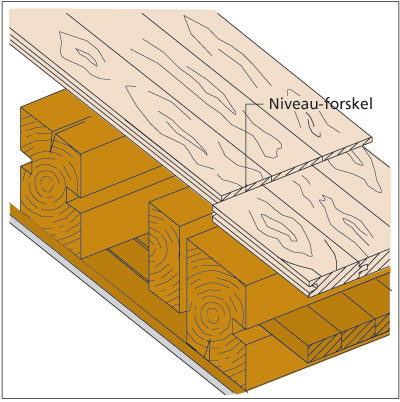
Figur 2. Niveauforskel i undergulvet.
Bæreevne
Gulvunderlaget skal være i stand til at overføre de belastninger, der kan forventes ved den forudsete brug, uden at der opstår skader eller uacceptable deformationer.
Styrke og stivhed
Gulve, inkl. underlag/undergulv, skal kunne modstå de statiske og dynamiske belastninger fra nyttelast, møbler, reoler, personer og rullende færdsel, fx pallevogne eller lignende, som må forventes at forekomme ved den påtænkte brug. Gulvet må ved den påtænkte brug ikke få så store deformationer, at det generer brugen.
Revner og svage områder
Gamle afretningslag, som rettes op med spartelmasse eller lignende, skal ligge fast og være uden revner, huller og svage overfladelag. Undergulve, der ikke opfylder de nævnte krav, skal repareres partielt, inden spartling eller lignende påbegyndes. Reparationer af den nævnte art er vanskelige at prissætte. Hvis de indgår i en entreprise, skal de gøres entydige i udbuds- og aftalegrundlaget ved fastlæggelse af udførelsesmetode og omfang, fx antal løbende m eller m2.
Aftagning af eksisterende gulvbelægning
På gulve kan der gennem en årrække være lagt flere lag gulvbelægning og afretning oven på hinanden.
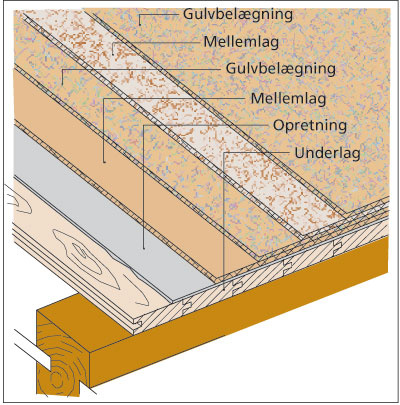
Figur 3. Eksempel på kombination af flere lag gulvbelægning og afretning.
Hvis aftagning af eksisterende belægning på gulve eller trapper indgår i entreprisen, skal det derfor fremgå af udbuds- og aftalegrundlaget, hvor mange lag ydelsen indeholder, dvs. hvor mange lag gulvbelægning mv., der skal fjernes.
"Gulv på gulv"
Det anbefales normalt ikke at lægge en ny gulvbelægning oven på en gammel gulvbelægning. For halvhårde belægninger, fx linoleum og vinyl, kan det være direkte risikabelt at lægge lag på lag, da der kan opstå vedhæftningsproblemer mellem lagene, blødgørervandringer, svigt i underliggende lag mm. Et gammelt stabilt trægulv kan derimod være særdeles velegnet som undergulv for næsten en hvilken som helst anden type gulvbelægning.
Aftagning af træfiberplader
Hvis gamle træfiberplader skal aftages, skal det præciseres, at ydelsen også omfatter de søm eller klammer, som har fastholdt pladerne til underlaget.
Fjernelse af fodlister
Normalt nedtages gamle fodlister i forbindelse med gulvrenovering. Inden gulvarbejdet påbegyndes er det vigtigt, at der foretages nødvendige reparationer af den bagvedliggende puds. Dette gælder især vægarealer, hvor nye fodlister skal limes fast.
Installationer
Installationer er ofte udført skjult under gulvet. Fx er det ikke ualmindeligt, at varmeanlæggets forsyningsrør samt rør og kabler til elinstallationer er placeret under gulvet, ligesom gulvet kan være udført med gulvvarme. Sjældnere ses rør for brugsvand og afløb placeret under gulve. Rørinstallationer i gulvkonstruktioner giver normalt ingen problemer ved renovering af gulve. Derimod er det vigtigt, at der er klarhed over installationernes placering ved ombygninger, der kræver indgreb i gulvkonstruktionen. Hvis der er gulvvarme i konstruktionen, skal det fremgå af udbudsgrundlaget, da det kan få betydning for såvel arbejdsudførelsen, som gulvets fremtidige udseende og holdbarhed.
5.1.0.9 Renovering af trappe og gulv
I dette afsnit beskrives, hvordan gulve og trapper kan afrettes og gøres klar til pålægning af nye gulvbelægninger. Afsnittet suppleres af Renoveringsskemaerne øverst i højre menuspalte i Renovering. Disse skemaer kan anvendes som beskrivelsesgrundlag til brug ved projektering og udbud af gulventrepriser i renoveringsopgaver.
I eksemplerne indgår:
Indenfor hver type eksisterende undergulv vælges den ønskede (bedst egnede) afretningsmetode i Renoveringsskemaerne. Afretningsmetoderne er beskrevet i det følgende.
Bræddegulve
Ved renovering af gamle byejendomme er der tradition for, at gamle bræddegulve i entré og køkken pålægges en gulvbelægning, fx linoleum, vinyl, gummi eller polyolefine, mens trægulve i stuer og værelser afslibes og overfladebehandles.
Afslibning og overfladebehandling af trægulve er beskrevet i afsnittet om Overfladebehandling. Det efterfølgende omhandler derfor kun bræddegulve, som benyttes til undergulv for en gulvbelægning.
Figur 5. Anvendelige afretningsmetoder på bræddegulv.
Forudsætninger
Bræddegulvet skal være bæredygtigt, plant og tørt. Ved bjælkelag og strøkonstruktioner skal gulvbrædderne være godt fastholdt til underlaget, og fer og not-samling skal være intakt. Ved svømmende gulve skal gulvfladen være sammenhængende, dvs. brædderne skal være indbyrdes sammenholdt ved hjælp af bøjler eller ved sammenlimning i fer og not.
Gulve, der spartles, skal være fri for spild af olie, fedt, voks og lignende urenheder. Lak- eller malebehandling på gulvoverfladen skal sidde fast. Bræddegulve på terrændæk, kælderdæk mv., hvor fugtopstigning eller høj relativ luftfugtighed kan forekomme, skal være effektivt beskyttet mod fugt.
Fiberspartelmasse og spartelmasse på armeringsnet
På stabile bræddegulve kan der anvendes fiberspartelmasse eller spartelmasse på netarmering uden efterfølgende afdækning med træfiberplader. Metoderne Gu-2 og Gu-3 anbefales dog kun anvendt på trægulve som ikke påvirkes af fugt nedefra, fx fra vaskekældre eller lignende rum. Gulvbrædderne skal ligge fast, og fugtindholdet skal være mindst 8% og højst 10%. I tynde gulvbelægninger må der påregnes aftegninger af ujævne gulvbrædder.
Bræddegulve med stort slid
Slidte bræddegulve kan oprettes og forstærkes ved hjælp af spån-, krydsfinér- eller MDF-plader, som lægges på et lag gulvpap, limes i fer og not, og skrues fast til bræddegulvet, metode Gu-4. Afhængig af den valgte pladetykkelse og/eller gulvets planhed kan det blive nødvendigt at spartle bræddegulvet, før pladerne pålægges. Endvidere kan slidte bræddegulve renoveres ved at udlægge et svømmende undergulv af træ- eller gipsbaserede plader ovenpå det eksisterende gulv. Det svømmende gulv udlægges på et glidelag af pap eller lignende, metode Gu-5. Afhængig af den valgte pladetykkelse og gulvets planhed, kan det blive nødvendigt at spartle bræddegulvet, før pladerne pålægges.
Hængende bjælker
Hængende bjælker i etageadskillelser af træ er ofte bestemmende for den planhed, der kan opnås på den færdige gulvoverflade. Gamle træbjælkelag kan fx være dimensioneret med en maksimal nedbøjning på 1/500 del af bjælkernes spændvidde. En bjælke med maksimal nedbøjning vil fx over et spænd på 4 m hænge 8-10 mm. Med denne afvigelse på vandretheden er det med de hidtil omtalte opretningsmetoder ikke muligt at opnå en planhedstolerance mindre end ± 4 mm på 2 m. Ønskes bedre planhed og vandrethed, må det gamle bræddegulv oprettes med lette afretningsmaterialer, fx hørfibre eller perlite som underlag for et nyt svømmende gulv af træ- eller gipsbaserede plader. Alternativt kan det gamle bræddegulv udskiftes med et nyt gulv af brædder eller træbaserede plader, som udlægges på et nyt oprettet underlag på de gamle bjælker.
Pladesamlinger
Ved brug af afretningsmetoderne Gu-1, Gu-4 og Gu-5 må det påregnes, at pladesamlinger kan fremtræde svagt synlige gennem gulvbelægningen. Dette gælder især for ensfarvede og tynde belægninger, hvor pladesamlinger fx kan ses ved lysindfald fra vinduer og dørpartier eller ved strejflys.
Undergulv af træ- eller gipsbaserede plader
Gennem en lang årrække er træ- og gipsbaserede plader anvendt til undergulve for bl.a. halvhårde- og textile gulvbelægninger. Til selvbærende undergulve på bjælkelag eller strøkonstruktioner er benyttet krydsfinér- eller spånplader. Til svømmende undergulve er benyttet såvel træsom gipsbaserede plader. På spartlede bræddegulve er benyttet 3-4 mm fastgjorte træfiberplader, som underlag for gulvbelægninger af linoleum og vinyl. Ofte kræver de nævnte pladetyper kun et minimum af forarbejde, før der kan pålægges ny gulvbelægning.
Figur 6. Anvendelige afretningsmetoder på pladegulve.
Forudsætninger
Pladegulvet skal være bæredygtigt, plant og tørt. Hvis den nye gulvbelægning skal klæbes på, eller hvis pladegulvet skal spartles, skal overfladen være hel og fri for spild af olie, fedt, voks eller andre urenheder. Træfiberplader skal være udlagt med forskudte tværsamlinger og fastholdt til underlaget med søm, klammer eller lim. Undergulve af træ- eller gipsbaserede plader, skal være udlagt med forskudte tværsamlinger og være limet i fer og not eller fals. Endvidere skal pladegulve på bjælkelag eller strøkonstruktioner være uden knirkelyde og fastgjort forsvarligt til underlaget med søm eller skruer. Pladekanter langs vægge og lign. skal være fuldt understøttede.
Særlige forhold
Samlinger i krydsfinér-, spån- og træfiberplader samt skrue- og sømhuller i krydsfinér- og spånplader må ikke spartles. Normalt skal undergulve af gipsplader for textile og halvhårde gulvbelægninger være fuldspartlet. Gipspladeleverandøren bør eventuelt spørges til råds herom.
Afslibning
Eksisterende undergulve af krydsfinér-, spån- eller træfiberplade vil normalt kunne pålægges en ny gulvbelægning efter afslibning, metode Gu-6, som fjerner efterladte limstrenge fra den gamle gulvbelægning.
Gamle lime
Vær opmærksom på at gamle gulvbelægninger kan være klæbet på med sulfitbaseret lim. Har denne limtype været anvendt, anbefales det først at bortslibe mest muligt af limen og derefter at genskabe en egnet klæbebund med en ufortyndet primer og en spændingsfattig spartelmasse.
Leverandører af spartelmasser kan rådgive nærmere herom.
Fiberspartelmasse og spartelmasse på armeringsnet
På stabile pladegulve kan der anvendes fiberspartelmasse eller spartelmasse på netarmering uden efterfølgende afdækning med træfiberplader. Metoderne Gu-8 og Gu-9 anbefales kun anvendt på pladegulve som, som ikke påvirkes af fugt nedefra, fx fra vaskekældre eller lignende rum. Pladegulvet skal ligge fast og have et fugtindholdet på mindst 8% og højst 10%. I tynde gulvbelægninger må der påregnes aftegninger af pladesamlinger.
Hængende bjælker
Hængende bjælker i etageadskillelser af træ er ofte bestemmende for den planhed, der kan opnås på den færdige gulvoverflade. Gamle træbjælkelag kan fx være dimensioneret med en maksimal nedbøjning på 1/500 del af bjælkernes spændvidde. En bjælke med maksimal nedbøjning vil fx over et spænd på 4 m hænge 8-10 mm. Med denne afvigelse på vandretheden er det med de hidtil omtalte afretningsmetoder ikke muligt at opnå en planhedstolerance mindre end ± 4 mm på 2 m. Ønskes bedre planhed og vandrethed, må det gamle pladegulv oprettes med lette afretningsmaterialer, fx hørfibre eller perlite som underlag for et nyt svømmende gulv af træ- eller gipsbaserede plader. Alternativt kan de gamle plader udskiftes med et nyt gulv af træbaserede plader, som udlægges på et nyt oprettet underlag på de gamle bjælker.
Pladesamlinger
Ved brug af afretningsmetoderne Gu-6 og Gu-7 må det påregnes, at pladesamlinger kan fremtræde svagt synlige gennem gulvbelægningen. Dette gælder især for ensfarvede og tynde belægninger, hvor pladesamlinger fx kan ses ved lysindfald fra vinduer og dørpartier eller ved strejflys.
Undergulv af beton samt anhydrit- eller cementbaseret afretningslag
Gamle betongulve og gulve med anhydrit- eller cementbaserede afretningslag kan afrettes med spartelmasse eller med anhydrit- eller cementbaseret flydemørtel. Endvidere kan afretning foretages ved brug af træ- eller gipsbaserede plader, udlagt på PE-folie og pap eller på PE-folie kombineret med trinlydsdæmpende materialer, fx ovntørret sand eller granulerede afretningsmaterialer. Hvor der er risiko for opstigende fugt, fx ved terrændæk og kældergulve, kan der fx anvendes støbeasfalt eller flydemørtel, udlagt på en fugtspærre af PE-folie eller lignende.
Figur 7. Anvendelige afretningsmetoder på undergulv af beton, cement- eller anhydritbaseret afretningslag.
Forudsætninger
Ved afretning med spartelmasse eller flydemørtel med vedhæftning til underlaget, metoderne Gu-11, Gu-12 og Gu-16, skal underlaget ligge fast og være bæredygtigt og tørt. Huller og revner skal være repareret, og svage overfladelag afslebet. Overfladen skal være fri for spild af olie, fedt, voks og lign. urenheder. Eventuelle rester af limstrenge fra en tidligere gulvbelægning skal sidde fast. Hvis der stilles krav om bestemte styrkeegenskaber i afretningslaget, skal underlagets styrkeegenskaber mindst være i overensstemmelse hermed. Ved håndspartling over større arealer, metoderne Gu-11 og Gu-16, skal underlaget have en tolerance på højest ± 3 mm på et 2 m retholt. Opnåelige tolerancer og vejledende materialeforbrug er nærmere beskrevet i afsnittet Afretning/spartling.
Særlige forhold
Dårlige afretningslag skal fjernes og erstattes af nye. Afretningslag af anhydritbaseret flydemørtel er fugtfølsomt, og skal derfor beskyttes effektivt mod fugt. I renoveringssager kan afretningens tykkelse blive afgørende for hvilken løsning, der kan anvendes. Cementbaseret flydemørtel kan normalt udlægges i tykkelser fra 6 mm, mens anhydritbaseret flydemørtel kræver en gennemsnitstykkelse på mindst 25 mm og vil normalt ikke kunne udlægges i tykkelser under 15 mm. Når flydemørtler udlægges på membran, kræves tykkelser på 30-40 mm. Støbeasfalt udlægges normalt i tykkelser på ca. 25 mm.
Træ- og gipsbaserede plader på sandafretning fylder mindst 30 mm, mens træfiberplader udlagt på folie og pap kan lægges i tykkelser fra 7 - 10 mm. Hvis der skal klæbes tætte gulvbelægninger, som fx linoleum eller vinyl på støbeasfalt, skal asfalten forinden påføres et ca. 2 mm tykt lag af en spændingsfattig spartelmasse for at forbedre limens vedhæftning.
Pladesamlinger
Ved brug af afretningsmetoderne Gu-15 og Gu-16 må det påregnes, at pladesamlinger kan fremtræde svagt synlige gennem gulvbelægningen. Dette gælder især for ensfarvede og tynde belægninger, hvor pladesamlinger fx kan ses ved lysindfald fra vinduer og dørpartier eller ved strejflys.
Gulve af terrazzo, magnesit, klinker, fliser, naturskifter og lignende
Gamle gulve af terrazzo eller magnesit og gulve af klinker, fliser, mosaikstifter og lign., kan afrettes med spartelmasse. Ved meget ujævne gulvoverflader kan benyttes anhydrit- eller cementbaseret flydemørtel. Hvis gulvoverfladen har fine revner, kan afretningslaget evt. forstærkes med et armeringsnet af glasfiberarmeret polyester eller lign., som klæbes fast til gulvet, før afretningslaget udlægges. Hvor der er risiko for opstigende fugt, fx ved terrændæk og kældergulve, kan der anvendes støbeasfalt eller flydemørtel på en fugtspærre af PE-folie eller lignende. Afretning kan også foretages ved hjælp af træ- eller gipsbaserede plader, udlagt som svømmende undergulv på PE-folie og pap. Afhængig af det gamle gulvs planhed, kan spartling af underlaget være nødvendig, før pladerne udlægges.
Figur 8. Anvendelige afretningsmetoder på gulve af terrazzo, magnesit, klinker, fliser, naturskifer og lign.
Forudsætninger
Gulvet skal være bæredygtigt, plant og tørt og med fuld vedhæftning til underlaget. Klinker, fliser og lign. skal have fyldte fuger. Overflader, som spartles eller pålægges tyndpuds, skal være fri for spild af olie, fedt, voks og lign. urenheder. Huller, større revner og svage områder i terrazzo- og magnesitgulve skal være repareret, før afretning med spartelmasse eller tyndpuds. Hvis der stilles krav om bestemte styrkeegenskaber i afretningslaget, skal underlagets styrkeegenskaber mindst være i overensstemmelse hermed. Ved håndspartling over større arealer, metode Gu-17, skal underlaget have en tolerance på højest ± 3 mm på et 2 m retholt. Opnåelige tolerancer og vejledende materialeforbrug er nærmere beskrevet i afsnittet Afretning/spartling.
Særlige forhold
Gulve af terrazzo, magnesit, klinker og lign. er normalt vedligeholdt med produkter på linoliebasis. Inden brug af afretningsmetoderne Gu-17 eller Gu-18 kræves derfor en kemisk eller mekanisk afrensning af overfladen for at fjerne den overfladefilm, vedligeholdelsesprodukterne har efterladt. Gulve af terrazzo og magnesit er normalt ført op i hulkehl ved vægge og søjler, mens gulve af klinker og fliser kan være afsluttet med hulkehl-fliser. I sjældnere tilfælde er anvendt fodlister i træ. For at sikre det nye gulv en tilfredsstillende afslutning, skal hulkehle, sokkelfliser og lign. fjernes, før arbejdet påbegyndes. I renoveringssager kan afretningens tykkelse blive afgørende for hvilken løsning, der kan anvendes. Cementbaseret flydemørtel kan normalt udlægges i tykkelser fra 6 mm, mens anhydritbaseret flydemørtel kræver en gennemsnitstykkelse på mindst 25 mm og vil normalt ikke kunne udlægges i tykkelser under 15 mm.
Når flydemørtler udlægges på membran, kræves tykkelser på 30-40 mm. Støbeasfalt udlægges normalt i tykkelser på ca. 25 mm. Træ- og gipsbaserede plader på plastfolie og pap kan lægges i tykkelse fra 7 - 22 mm afhængig af materiale og pladetype.
Pladesamlinger
Ved brug af afretningsmetode Gu-20 må det påregnes, at pladesamlinger kan fremtræde svagt synlige gennem gulvbelægningen. Dette gælder især for ensfarvede og tynde belægninger, hvor pladesamlinger fx kan ses ved lysindfald fra vinduer og dørpartier eller ved strejflys.
Undergulv af støbeasfalt
Støbeasfalt er igennem mange år benyttet som gulvbelægning i fx fabrikslokaler og på skoler, kontorer, kaserner og lign. steder. Asfaltgulve har ofte en karakteristisk sort- eller rødbrun farve, men findes også i andre farver. Støbeasfalt er endvidere anvendt som undergulv for både trægulve og halvhårde gulvbelægninger som linoleum, vinyl og gummi. Gulvbelægninger af støbeasfalt kan afslibes og overfladebehandles med specielt fremstillede behandlingsmidler (maling), som fås i flere forskellige farver. Før gulvet afslibes og overfladebehandles, skal evt. revner brændes sammen og beskadigede områder fornyes. Gamle undergulve af støbeasfalt kan afrettes ved spartling eller ved pålægning af træ- eller gipsbaserede plader, udlagt som svømmende undergulv på et glidelag af pap eller lign. Afhængig af det gamle undergulvs planhed, kan en primning og spartling være nødvendig, før pladerne udlægges.
Figur 9. Anvendelige afretningsmetoder på gulve og undergulve af støbeasfalt
Gulvbelægning af støbeasfalt
Afslibning og overfladebehandling af gamle asfaltgulve (metode Gu-21) vil ikke blive yderligere omtalt. For yderligere oplysninger henvises til leverandører af asfaltgulve.
Undergulv af støbeasfalt
Forudsætninger
Undergulvet skal være bæredygtigt, plant og tørt. Overflader som primes og spartles skal være frie for spild af olie, fedt, voks og lign. urenheder. Huller, revner og svage områder i asfaltlaget skal være repareret, før spartling påbegyndes. Revner i asfaltgulve kan sammenlimes med en speciel epoxytype eller smeltes sammen ved hjælp af varme. Hvis der er tale om fine revner i et mindre omfang, kan spartellaget evt. forstærkes med armeringsnet eller lign., som klæbes til asfaltgulvet, før spartlingen udføres. Svage områder kan udskiftes med ny asfalt, som uden problemer kan smeltes sammen med den gamle asfalt. Ved håndspartling over større arealer, skal underlaget have en tolerance på højest ± 3 mm på et 2 m retholt. Opnåelige tolerancer og vejledende materialeforbrug er nærmere beskrevet i afsnittet Afretning/spartling.
Særlige forhold
Gamle asfaltgulve og undergulve af støbeasfalt kan være lagt på et trinlyddæmpende materiale af træuldbetonplader og isoleringsmåtter. Som følge af mange års belastning af gulvet kan de trinlyddæmpende lag være sunket sammen, hvorved asfaltlaget bliver ustabilt og må udskiftes eller repareres partielt. Asfaltlag har svært ved at optage de forskydninger, der opstår i forbindelse med spartelmassens hærdning. Der bør derfor altid benyttes spændingsfattige spartelmasser i lagtykkelser på ca. 2 mm.
Trappetrin af træ
Trapperummet er på grund af den store daglige belastning normalt det mest nedslidte rum i en ejendom. I etageejendomme med trætrapper ses dette tydeligst på indgangsreposen og trinene på det første trappeløb. Sliddet aftager normalt opefter i trapperummet.
Figur 10. Anvendelige afretningsmetoder på trappetrin af træ.
Trin i gamle trapper af træ kan afrettes ved at benytte en af ovenstående metoder. Valg af metode vil være afhængig af trinnets slid og den afslutningsskinne, som skal beskytte den nye belægning ved trinforkanten.
.jpg)
Figur 11. Trin på bitrapper og mange hovedtrapper i den gamle boligmasse har aldrig været belagt med fx linoleum og er derfor i gennem årene blevet udsat for stor slidtage. Dette ses tydeligt fra trinforkanten og ind mod stødtrinnet samt ud mod de to trappevanger, hvor trinfladen kan være endog særdeles hul.
Forudsætninger
Trappen skal være stabil og bæredygtig. Trin og reposer skal være tørre og frie for spild af olie, fedt, voks og lign. urenheder. Lak- eller malebehandling på trinoverflader og på reposernes gulve skal sidde fast for, at der kan spartles på dem.
Afretningsmetoder
Tr-1 Opforing med liste kan benyttes på trin, som har været beskyttet mod slid af henholdsvis belægning og forkantskinne.

Figur 12. Opforing med liste.
En 21 mm bred høvlet fyrretræsliste tilpasses i højden, så oversiden er i niveau med - eller lidt over trinnets højeste punkt, og fastgøres i falsen efter den gamle forkantskinne. Herefter spartles trinfladen imellem listen og stødtrinnet. Indklinkning anvendes på trin, som ikke har været beskyttet mod slid, og derfor er slidt hule i ganglinien.
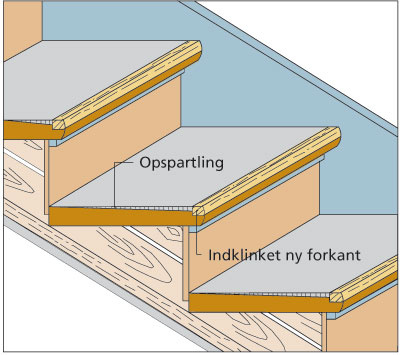
Figur 13. Indklinkning med liste.
Afhængig af sliddet kan der benyttes en 12 x 12 mm eller 21 x 21 mm fyrretræsliste. Listen fræses ned i trinforkanten og fastgøres, så oversiden er i niveau med - eller lidt over trinnets højeste punkt. Herefter spartles trinfladen imellem listen og stødtrinnet.
Tr-3
En ny trinforkant kan med fordel benyttes på trin med stort slid.
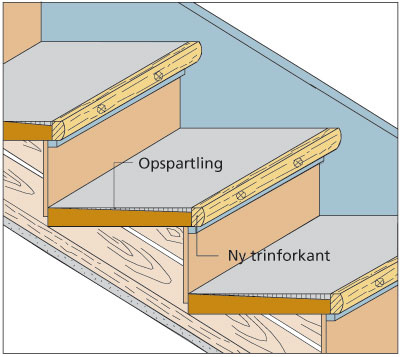
Figur 14. Ny trinforkant i træ.
Den gamle trinforkant skæres af ved platlisten og erstattes med den nye trinforkant, som limes og skrues fast til den tilbageblevne del af trinnet. Herefter spartles trinfladen mellem den nye trinforkant og stødtrinnet. Den nye trinforkant kan være med eller uden fals til ny trinforkantskinne.
Tr-4
Til trin med stort slid kan endvidere benyttes opretningsskinner af metal.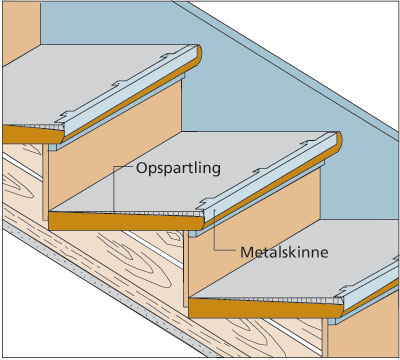
Figur 15. Opretningsskinne af metal.
Skinnen løftes i niveau med eller lidt over trinnets højeste punkt og fastgøres til trinforkanten med skruer eller søm. Herefter spartles trinfladen mellem skinnens opbukkede kant og stødtrinnet. Metoden kræver anvendelse af en trinforkant med "næse" for at skjule metalskinnen på trinforkanten.
Reposer
Spartling af bræddegulve på reposer følger retningslinierne for opretning på gamle bræddegulve. Der henvises derfor til side 14.8 - afretningsmetoder på bræddegulve.
Gangsikkerhed
Udtrin i trætrapper har tendens til at dykke i forkanten. Årsagen kan være sætninger mellem trappeløbet og de bærende reposer. Udtrinnet, som er fastholdt i begge dele, får derved en større eller mindre hældning. Hvis gulvet på reposen inkl. udtrinnet skal rettes op til en acceptabel tolerance, vil den sidste stigning før reposen blive større end de øvrige stigningerne i trappeløbet. Hvis stigningsforskellen er mere end 10 mm, bliver trappen ubehagelig at færdes på og bør derfor udjævnes over 2-3 forudgående trin, fx ved påforing af krydsfinér eller lign. i varierende tykkelser.
Vandrethed
Det vil normalt ikke være muligt at oprette trin i gamle trætrapper til vandrethed, idet muligheden herfor begrænses af afstanden mellem trappevangens overkant og trinnets forkant samt af trappeløbenes tilslutning til reposerne.

